The Provence class were ten broadside ironclads built in the follow-up of the Gloire class in 1859. They were all laid down in 1961, launched 1863-65 and completed in 1865-67. They were an evolution of the earlier Gloire-class ironclads, incorporating thicker armor and heavier armament, while still having a wooden hull. They were quickly involved in the Franco-Prussian war, their major engagement, marred however by the lack of coal. The blockade of the Prussian coast, partly in the Baltic, in Danish waters and in the Heligoland bight was cut short and many gunners of these ships ended in the defense of the besieged Paris in 1871. These ironcalds then went in and out of reserve, split between the Northern and Medietrannean Squadrons, but some seeing further actions in the Levant, Tunusia, Greece among others. The last was still a utility hulk in 1901, but most had been scrapped in the 1880s after limited modernization. They still represented by their mass, ten ironclads of the same model, the bulk of the French ironclad fleet for more than a decade, alongside more fancyful and costly ships such as the Magenta class, and the rise of central battery ships.
Design of the class
The Provence class was designed by naval architect Henri Dupuy de Lôme as an enlarged version of the Gloire-class ironclads with thicker armor, more powerful guns, and better seakeeping qualities. Henri Dupuy de Lôme, a prominent French naval architect known for pioneering ironclad design. As broadside ironclads, their primary armament was mounted along the sides of the ship to fire broadsides but given the French industrial limitations of the time they were built from wooden hulls reinforced by an iron frame, blending traditional wooden shipbuilding with ironclad technology. They were of “mixed construction” and teak backed the wrought iron plating. They displacement was around 5,800 tons for 82.9 meters (272 ft) in length on average. Indeed, they were ordered on 16 November 1860 by Napoleon III, impressed by the Gloire, to five different yards, Cherbourg, Brest, Lorient, Rochefort, which were unacustomed to work on these vessels, unlike Toulon which built three ships alone and was better suited to respect stringent specifications. The latter yard made the lead ship and sent the detailed plans to other yards, but still, end specificatiosn differend between vessels.
The ships were all protected by 4.7 to 5.5 inches (120-140 mm) of wrought iron armor along their sides backed by teak as said, but they also featured armored casemates for additional protection of their main guns, a significant improvement over the previous class while their deck armor was lighter but provided some resistance to plunging fire. The Provence-class ironclads were initially armed with 30 to 40 rifled muzzle-loading guns, although this varied between ships. The primary guns were 164.7 mm (6.5 in) rifled cannons were mounted at the center. The class was later rearmed with heavier, more modern M1970 240 mm (9.4 inches) guns. For propulsion it was decided to have them powered with a single screw propulsion system, for 13 knots, coal-fired, but with masts and sails as backup for extended range and fuel efficiency.
Hull and general design
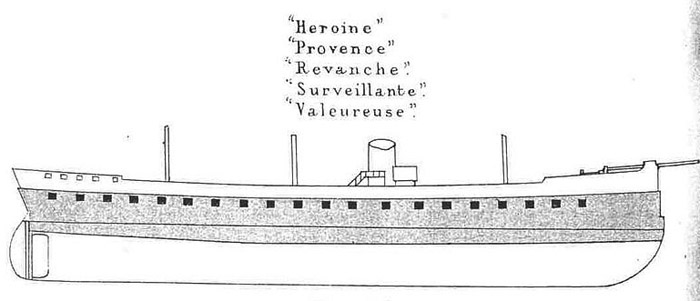
The Porvence class ironclads had an overall length of 82.9 meters (272 ft) for a beam of 17.06 meters (56 ft), and draft of 8.4 meters (27 ft 7 in) deeply load. They displaced 5,810 metric tons (5,720 long tons)on average, but Héroïne was the only one notto have a wooden hull. She was the indeed the first made with an iron hull, at Lorient shipyard. The Provence-class ships metacentric height was about 1.4 meters (4.5 ft) and lessons had been learned, they did not roll as badly as the Gloires. The crew was substantial, at 579–594 officers and enlisted men. For details of their design, they were replicas of the Gloire class, so check that article.
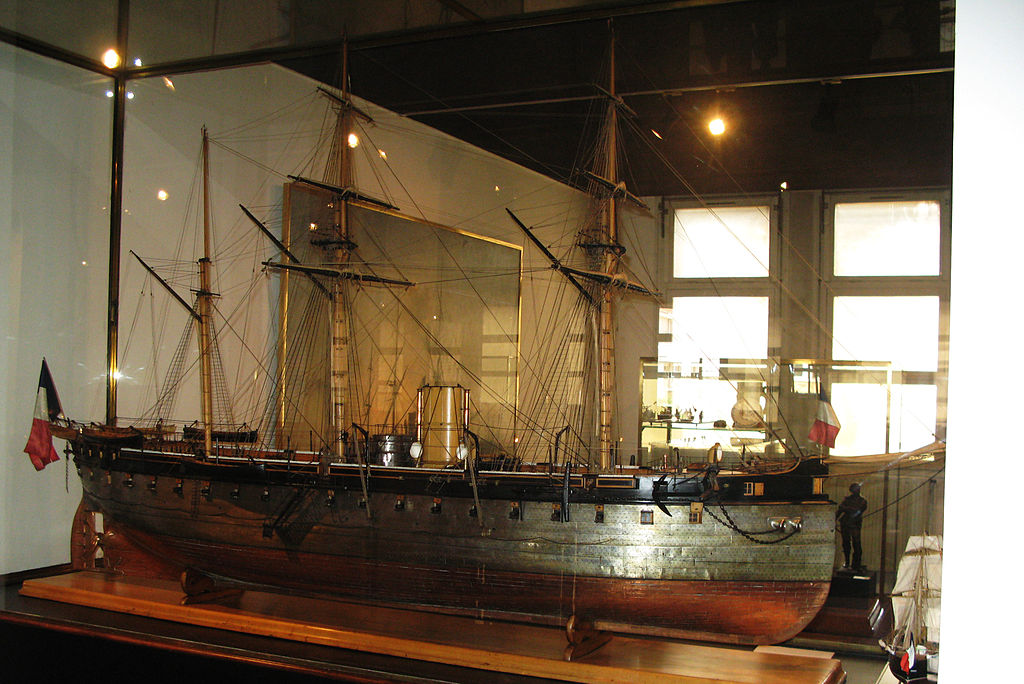
A model of Flandre at the Maritime Museum in Paris
Powerplant
The ships Provence class were powered by a single horizontal-return connecting-rod compound steam engine as the previous class but with increased power. It drove a four-bladed, 6.1-meter (20 ft) propeller. Steam came from eight boilers working at a maximum pressure of 1.8 kg/cm2 (177 kPa; 26 psi) for a rating of 1,000 nominal horsepower (3,200 metric horsepower/2,400 kW). On paper this was suffcient to bring them above 13 knots (24 km/h; 15 mph). Available records of sea trials which were kept to this day showed they could inded achieve between 13.2 and even 16.5 knots (24.4–30.6 km/h; 15.2–19.0 mph) based on 2,918–3,895 metric horsepower (2,146–2,865 kW) as again, the yards had someleeway in the engnes and boilers they provided. Still, 16.5 knots was excellent for a broadside ironclad in the 1860s. The Provence class also had varied coal storage capacities ranging from 590 to 640 t (581–630 long tons), enough to steam over 2,410 nautical miles (4,460 km; 2,770 mi) at 10 knots (19 km/h; 12 mph). Their three-masted barque rig completed this, with a sail area of 1,960 square meters (21,100 sq ft). No change froml the Gloire class on this.
The class mobility was called into question during the blockade attempt of Prussia. Despite being sail-powered as auxiliary, the ships still needed coal for their regular service in operation. But between Denmark refusing to enter the war, and Britain denying the French the possibility to recoal, this left this operation to be performed at sea, in rough condition, which proved nigh-impossible. This was the main reason why the French Navy, which dwarved the Prussian Navy, could do little in this short war which was decided on land. Unlike the Royal Navy, the French Navy never created a solid network of coaling points for its needs, despite having an Empire. This was far more consistent in the Mediterranean.
Protection
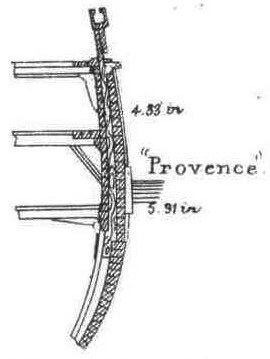 Left: Cross-section of the armor of the Provence class. From the upper deck down to below the waterline the Provence class had sides completely armored with 150 mm (5.9 in) of wrought iron. The battery was protected by light, still 110 mm (4.3 in) thick armor. The conning tower identical to the Gloire class had sides walls 102-millimeter (4 in) thick.
Left: Cross-section of the armor of the Provence class. From the upper deck down to below the waterline the Provence class had sides completely armored with 150 mm (5.9 in) of wrought iron. The battery was protected by light, still 110 mm (4.3 in) thick armor. The conning tower identical to the Gloire class had sides walls 102-millimeter (4 in) thick.
Armament
The main battery of the Provence-class was setup to take advantage initially of thirty 164.7-millimeter (6.5 in) Modèle 1858–60 rifled muzzle-loading (RML) guns.
This was changed during construction to eleven 194-millimeter (7.6 in) Modèle 1864 smoothbore muzzle-loading guns (SML) in 1865 as their performances were judged better. Naval historian N. J. M. Campbell stated that Flandre, Provence and Héroïne, first completed, had ten 164.7 mm smoothbores, twenty-two 164.7 mm RMLs, two 220-millimeter (8.7 in) RML howitzers on the upper deck. Ten 194 mm Modèle 1864 guns were in the broadside, one on pivot mount below the forecastle deck (chase gun). In 1871, so after the Franco-Prussian war, their only modernization constited in fitting eight 240-millimeter (9.4 in) RMLs and four 194 mm smoothbores, so just six guns per side. There was no known modernization and the ship spent a great deal in reserve during their career, ending mostly in 1878-1880. Some care was brought to their hull also as no issue was found with it ageing relatively well. The last of these was still around in 1901 but she was the only iron-hulled of the serie, Heroine.
⚙ Provence class specifications |
|
| Displacement | 5,810 t (5,720 long tons) |
| Dimensions | 2.9 x 17.06 x 8.4m (272 x 56 x 27 ft 7 in) |
| Propulsion | 1 shaft, HRC rod-steam engine, 8 boilers 2,918–3,895 PS (2,146–2,865 kW), Barque-rig |
| Speed | 13.2–16.5 knots (24.4–30.6 km/h; 15.2–19.0 mph) (trials) |
| Range | 2,410 nautical miles (4,460 km; 2,770 mi) at 10 knots (19 km/h; 12 mph) |
| Armament | 11 × single 194 mm (7.6 in) smoothbore muzzle-loading guns |
| Protection | Belt 150 mm (5.9 in), Battery 110 mm (4.3 in), CT 100 mm (4 in) |
| Crew | 579–594 |
Gallery
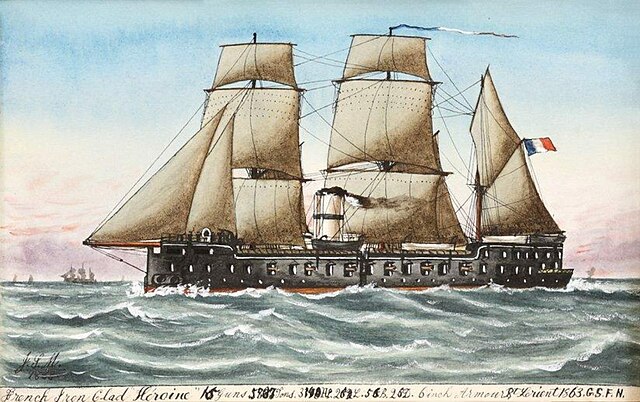
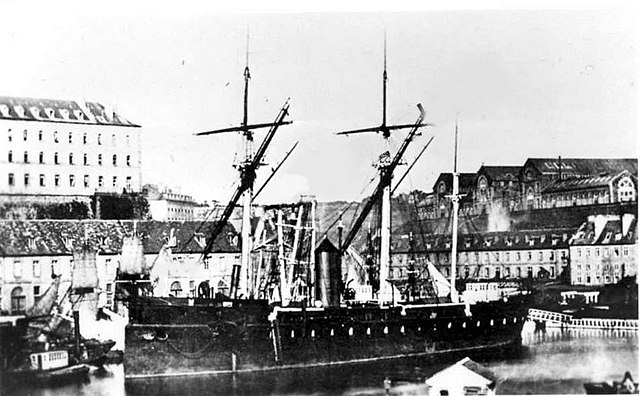
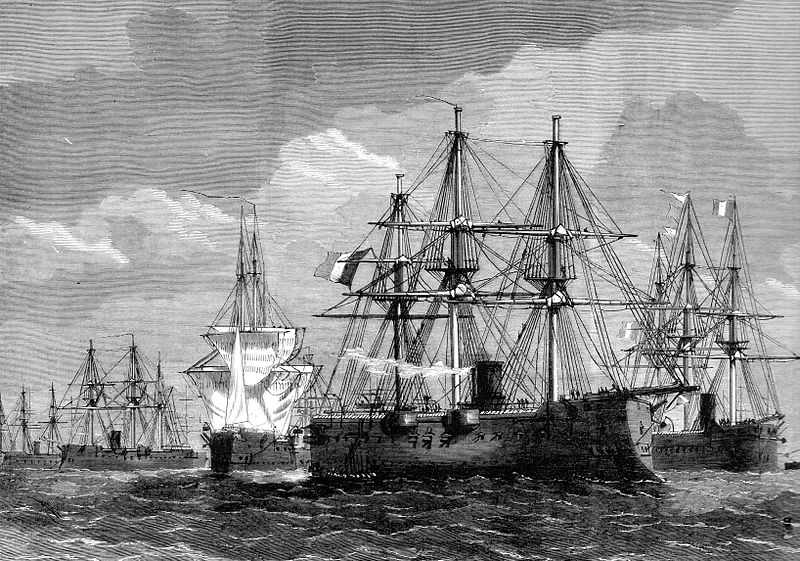

Read More/Src
Books
de Balincourt, Captain; Vincent-Bréchignac, Captain (1975). “The French Navy of Yesterday: Ironclad Frigates: Second Group – Provence Type”. F.P.D.S. Newsletter. III (2):
Campbell, N. J. M. (1979). “France”. In Chesneau, Roger & Kolesnik, Eugene M. (eds.). Conway’s All the World’s Fighting Ships 1860–1905.
Gille, Eric (1999). Cent ans de cuirassés français [A Century of French Battleships] (in French). Nantes: Marines.
Konstam, Angus (2019). European Ironclads 1860–75: The Gloire Sparks the Great Ironclad Arms Race. Oxford, UK: Osprey Publishing.
Roberts, Stephen S. (2021). French Warships in the Age of Steam 1859–1914: Design, Construction, Careers and Fates. Barnsley, UK: Seaforth Publishing.
Silverstone, Paul H. (1984). Directory of the World’s Capital Ships. New York: Hippocrene Books.
Wilson, H. W. (1896). Ironclads in Action: A Sketch of Naval Warfare From 1855 to 1895. Vol. 1 and 2. Boston: Little, Brown.
Winfield, Rif & Roberts, Stephen S. (2015). French Warships in the Age of Sail, 1786–1861. Barnsley, UK: Seaforth Publishing.
Links
Ironclads in action; a sketch of naval warfare from 1855 to 1895
on dreadnoughtproject.org/
on navypedia.org/
Career of the Provence class Ironclads
 Flandre
Flandre
Flandre was laid down at Arsenal de Cherbourg on 28 January 1861 12 June 1864 May 1865 Condemned, 12 November 1886, assigned to the Ironclad Division (Division cuirassée) of the Northern Squadron in Cherbourg. She visited Madeira and Tenerife (Canary Is.) and with Magenta, visited Plymouth on 17–19 July for the Exhibition of the Royal Agricultural Society. The French invited the Channel Fleet to Cherbourg for Emperor Napoleon III’s birthday in August and the Mediterranean Squadron was invited back to Portsmouth until 2 September. By September–October 1866 Flandre, Magnanime, Héroïne, Magenta took part in combined and comparative gunnery drills and fleet maneuvers.
In January 1867, she collided with the British merchantman Brutus (Atlantic) and was repaired. With Magnanime and Magenta, she escorted transports ferrying French troops home after the expedition of Mexico failed in 1867. In 1869 she was flagship, RADM Charles de Dompierre d’Hornoy but from July 1870 with the war, she was assigned to Vice Admiral Édouard Bouët-Willaumez’s squadro toblockade ports from the Heligoland Bight, leaving Cherbourg on 24 July. She went through the Skagerrake and entered the Baltic for closer blockade, marred by the lack of coal and strong Prussian fortifications. Flandre and Océan were relieved by Rochambeau and Armide in August, sailed back to Cherbourg and returned into the Bight where it was provedn impossible to recal at Heligoland due to British Neutrality. She was back in early September and during the siege of Paris, sent half her gunners to the city. She resumed the blockade until December. Later she towed back Surveillante after she lost her rudder in a storm back to Cherbourg. She was paid off in Cherbourg, 18 March 1871, reactivated on 20 October 1873 to test a torpedo-outrigger system, rearmed in 1875 with new Modèle 1870 guns, but stayed in reserve until disarmed in November 1884, stricken 12 November 1886, scrapped in 1887.
 Gauloise
Gauloise
 Gauloise was laid down at Arsenal de Brest on 24 January 1861, launched on 26 April 1865, completed on 5 December 1867, assigned to the Ironclad Division, Northern Squadron in Cherbourg. On 24 July 1868, she was flagship, Rear Admiral Charles de Dompierre d’Hornoy. From July 1870, with the war, she was flagship for Rear Admiral Alexandre Dieudonné, second in command to Vice Admiral Édouard Bouët-Willaumez, tasked to blockade German ports in the Heligoland Bight from Cherbourg. He sailed to Danish waters and ordered on 2 August to proceed with half his forced woth the Baltic Sea and blockade directly Prussian ports. But between the lack of coal and strong Prussian coastal defenses he was ordered to return to Cherbourg on 16 September. Many of her gunners were sent to the defense of Paris. Instead of resuming the blockade, she was placed reserve at Brest in November, reactivated in 1872 as flagship, RADM Jean Hugueteau-Chaillé, Squadron of Evolutions (Mediterranean) detached to the Levant suadron, but in reserve in 1873 at Brest until 2 December 1875. She became flagship of RADM Benjamin Jaurès on 21 February 1876 then Ernest Fauque de Jonquières. In reserve, reactivated 18 April 1877, Squadron of Evolutions as flagship RADM Laurent Lejeune and then to the Levant Naval Division until 1879. She wa sin reserve in Cherbourg in 1880, stricken and BU 1884–1886.
Gauloise was laid down at Arsenal de Brest on 24 January 1861, launched on 26 April 1865, completed on 5 December 1867, assigned to the Ironclad Division, Northern Squadron in Cherbourg. On 24 July 1868, she was flagship, Rear Admiral Charles de Dompierre d’Hornoy. From July 1870, with the war, she was flagship for Rear Admiral Alexandre Dieudonné, second in command to Vice Admiral Édouard Bouët-Willaumez, tasked to blockade German ports in the Heligoland Bight from Cherbourg. He sailed to Danish waters and ordered on 2 August to proceed with half his forced woth the Baltic Sea and blockade directly Prussian ports. But between the lack of coal and strong Prussian coastal defenses he was ordered to return to Cherbourg on 16 September. Many of her gunners were sent to the defense of Paris. Instead of resuming the blockade, she was placed reserve at Brest in November, reactivated in 1872 as flagship, RADM Jean Hugueteau-Chaillé, Squadron of Evolutions (Mediterranean) detached to the Levant suadron, but in reserve in 1873 at Brest until 2 December 1875. She became flagship of RADM Benjamin Jaurès on 21 February 1876 then Ernest Fauque de Jonquières. In reserve, reactivated 18 April 1877, Squadron of Evolutions as flagship RADM Laurent Lejeune and then to the Levant Naval Division until 1879. She wa sin reserve in Cherbourg in 1880, stricken and BU 1884–1886.
 Guyenne
Guyenne
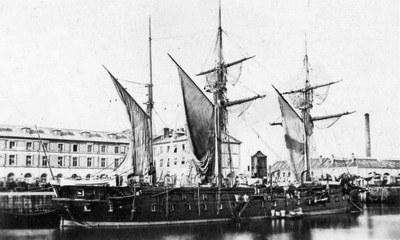 Guyenne was laid down at Arsenal de Rochefort on 11 February 1861, launched on 6 September 1865, completed on 6 November 1867, assigned to the Ironclad Division, Northern Squadron in Cherbourg. During the Franco-Prussian War she was in VADM Édouard Bouët-Willaumez’s squadron in the Heligoland Bight for the blockade, departing Cherbourg on 24 July and in Danish until further orders. Bouët-Williaumez was ordered to split his forces in half. Guyenne entered the Baltic Sea to blockade Prussian ports until returning to the Bight, unable to close due to strong coastal defenses but still disturbing German shipping. She was back in Cherbourg on 16 September and returned to the Bight. With the siege of Paris many of her gunners were transferred there. She resumed the blockade until December. She towed back home Surveillante after she lost her rudder in a storm on 12 October. Guyenne was paid off, disarmed in May 1871, in reserve until 1877, reactivated in the Channel Division, transferred to the Squadron of Evolutions (Mediterranean) and detached to the Eastern Mediterranean in 1878. She was in reserve at Toulon on 1 February 1879, stricken on 19 October 1882, BU 1887.
Guyenne was laid down at Arsenal de Rochefort on 11 February 1861, launched on 6 September 1865, completed on 6 November 1867, assigned to the Ironclad Division, Northern Squadron in Cherbourg. During the Franco-Prussian War she was in VADM Édouard Bouët-Willaumez’s squadron in the Heligoland Bight for the blockade, departing Cherbourg on 24 July and in Danish until further orders. Bouët-Williaumez was ordered to split his forces in half. Guyenne entered the Baltic Sea to blockade Prussian ports until returning to the Bight, unable to close due to strong coastal defenses but still disturbing German shipping. She was back in Cherbourg on 16 September and returned to the Bight. With the siege of Paris many of her gunners were transferred there. She resumed the blockade until December. She towed back home Surveillante after she lost her rudder in a storm on 12 October. Guyenne was paid off, disarmed in May 1871, in reserve until 1877, reactivated in the Channel Division, transferred to the Squadron of Evolutions (Mediterranean) and detached to the Eastern Mediterranean in 1878. She was in reserve at Toulon on 1 February 1879, stricken on 19 October 1882, BU 1887.
 Héroïne
Héroïne
 Héroïne was laid down at Arsenal de Lorient on 10 June 1861, launched on 19 December 1863 and completed on 7 June 1865. Assigned to the Ironclad Division, Northern Squadron in Cherbourg. She visited Plymouth on 17–19 July then was present in Cherbourg when inviting the Channel Fleet for Napoleon III’s birthday in August. By September–October 1866 with Magnanime and Flandre, and the new Magenta she took part in extensive fleet maneuvers and comparative gunnery trials. In the Squadron of Evolutions she became flagship, RADM Albert Gicquel des Touches in 1868 and Bernard Jauréguiberry in 1870 but the Franco-Prussian War saw her under Fourichon’s squadron order, sent to the Heligoland Bight. Cealing was impossible so she was back in early September. Many of her trained gunners to par in the defence of Paris but she later resumed the blockade closer to home. By mid-January 1871 she blockaded the German commerce raider SMS Augusta in Vigo until the Armistice of Versailles on 28 January.]
Héroïne was laid down at Arsenal de Lorient on 10 June 1861, launched on 19 December 1863 and completed on 7 June 1865. Assigned to the Ironclad Division, Northern Squadron in Cherbourg. She visited Plymouth on 17–19 July then was present in Cherbourg when inviting the Channel Fleet for Napoleon III’s birthday in August. By September–October 1866 with Magnanime and Flandre, and the new Magenta she took part in extensive fleet maneuvers and comparative gunnery trials. In the Squadron of Evolutions she became flagship, RADM Albert Gicquel des Touches in 1868 and Bernard Jauréguiberry in 1870 but the Franco-Prussian War saw her under Fourichon’s squadron order, sent to the Heligoland Bight. Cealing was impossible so she was back in early September. Many of her trained gunners to par in the defence of Paris but she later resumed the blockade closer to home. By mid-January 1871 she blockaded the German commerce raider SMS Augusta in Vigo until the Armistice of Versailles on 28 January.]
Héroïne was paid off on 14 April 1871 in Toulon, for five years, recommissioned on 21 January 1876 with the 2nd Division, Squadron of Evolutions. She was sent to Thessaloniki after the Salonika Incident (French and German Consuls murdered 6 May 1876). She teh joined the Levant Division on 22 May 1877 and Squadron of Evolutions but was placed in reserve in 1879, reactivated in 1882, reserve in 1886, disarmed, condemned on 10 January 1893, engine removed. On 11 January 1894 she was sent to Dakar (French West Africa) arriving on 6 February to be hulked as floating workshop. In January 1898 she became a floating battery until disarmed in January 1901, scuttled off Dakar on 29 December 1901 as preventative measure during an outbreak.
 Magnanime
Magnanime
Magnanime (Magnanimous) was laid down at Arsenal de Brest on 27 February 1861, launched on 19 August 1864, completed on 1 November 1865. Assigned to the Ironclad Division, Northern Squadron in Cherbourg, then Mediterranean Squadron. In September–October 1866 with Flandre, Héroïne, Magenta she took part in fleet maneuvers and compared gunnery trials, then escorted transports ferrying French troops home from Mexico in 1867. On 1 April 1870 she was assigned to the Squadron of Evolutions as flagship, VADM Martin Fourichon.
As the Franco-Prussian War started on 19 July she was deployed to Oran to intercept a possible Prussian ironcads attack. She was then ordered to Brest for the blockade the coast of Prussia, sent to Heligoland Bight from 8 August, arriving on the 11th. Britain denied permission to re-coal there and it was impossible at sea in bad weather and storms so she was back in early September. Mosy of her gunners were sent to defend a besieged Paris and she resumed the blockade until December. She was in reserve 1872–1875 at Toulon and on 21 October 1876 became flagship of Rear Admiral Ernest de Jonquières, Squadron of Evolutions (Mediterranean) then RADM Pierre Foullioy from 27 October 1877. She was paid off in 1878, condemned in 1879, stricken 19 June 1882, BU 1885.
 Provence
Provence
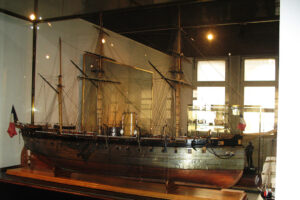 Provence, the lead ship, was laid down at Arsenal de Toulon on March 1861, launched on 29 October 1863 and completed on 1 February 1865, assigned to the Squadron of Evolutions (Escadre d’évolutions), Mediterranean Squadron. In May she escorted Emperor Napoleon III for a visit to French Algeria. Next the squadron departed to Brest in August for combined exercises with the Northern Squadro and a visit to the British Channel Fleet on 21–24 August and Portsmouth until 2 September. She was later was present in the Med when a statue of Vice Admiral Pierre André de Suffren was unveiled at Saint-Tropez on 4 April 1866. In the Third Italian War of Independence she ferried General Edmond Le Bœuf in the Adriatic Sea 16 July-20 October and became flagship of Rear Admiral Louis Pierre Alexis Pothuau in March 1868.
Provence, the lead ship, was laid down at Arsenal de Toulon on March 1861, launched on 29 October 1863 and completed on 1 February 1865, assigned to the Squadron of Evolutions (Escadre d’évolutions), Mediterranean Squadron. In May she escorted Emperor Napoleon III for a visit to French Algeria. Next the squadron departed to Brest in August for combined exercises with the Northern Squadro and a visit to the British Channel Fleet on 21–24 August and Portsmouth until 2 September. She was later was present in the Med when a statue of Vice Admiral Pierre André de Suffren was unveiled at Saint-Tropez on 4 April 1866. In the Third Italian War of Independence she ferried General Edmond Le Bœuf in the Adriatic Sea 16 July-20 October and became flagship of Rear Admiral Louis Pierre Alexis Pothuau in March 1868.
From July 1870, she was deployed to Oran (Algeria) to intercept Prussian ironcladd unnacounted for, until their presence was signalled back in Germany. She was sent to participate in the blockade, from Brest, under Fourichon’s squadron in Heligoland Bight. It was difficult to re-coal at sea and she was back in September, but had to send hald her gunners to Paris during the siege before resuming the blockade for a time.
She was paid off on 5 April 1871, disarmed but used from trials 18 March 1872–1873, then in reserve 1874, but rearmed and recommissioned on 7 December 1875, First Division, Squadron of Evolutions in 1876–1878. On 17 January 1879 she was flagship, RADM Laurent Joseph Lejeune, Eastern Mediterranean then RADM Léopold de Pritzbuer for the Levant Naval Division on 3 June, until relieved by Alfred Conrad on 1 August 1881. Condemned on 3 May 1886, hulked as target until sold on 10 November 1893, BU in Toulon.
 Revanche
Revanche
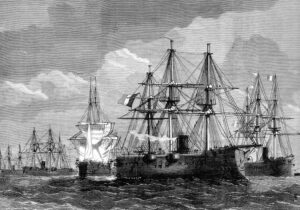 Revanche was laid down on 28 December 1865 and launched on 1 May 1867, commissioned for trials on 16 April 1867 and started service under Bernard Jauréguiberry (fure admiral). By 1870 she served with the Northern Squadron under Captain Laurent Lejeune and from July 1870 since a Prussian squadron of four ironclads were unaccounted for, the Mediterranean Squadron (Revanche included) was deployed to Oran in case they could intercept troop convoys to Metropolitan France. Then they were order to sail to Brest and took part of the blockade, with Vice Admiral Fourichon’s squadron for Heligoland Bight. She left Brest on 8 August but it wa sproven impossible to re-coal and she was back in early September. Many of her gunners were sent to take part in the defense of Paris but the ironclad resumed the blockade until smaller ships took it over.
Revanche was laid down on 28 December 1865 and launched on 1 May 1867, commissioned for trials on 16 April 1867 and started service under Bernard Jauréguiberry (fure admiral). By 1870 she served with the Northern Squadron under Captain Laurent Lejeune and from July 1870 since a Prussian squadron of four ironclads were unaccounted for, the Mediterranean Squadron (Revanche included) was deployed to Oran in case they could intercept troop convoys to Metropolitan France. Then they were order to sail to Brest and took part of the blockade, with Vice Admiral Fourichon’s squadron for Heligoland Bight. She left Brest on 8 August but it wa sproven impossible to re-coal and she was back in early September. Many of her gunners were sent to take part in the defense of Paris but the ironclad resumed the blockade until smaller ships took it over.
She was in reserve in Toulon, 20 March 1871, reactivated on 12 November 1875 as flagship, VADM Pierre-Gustave Roze. On 20 March 1877 she suffered a boiler explosion at Villefranche-sur-Mer, killing 26, wounding 60. She was repaired in Toulon and placed in reserve on 16 May but reactivated on 5 February 1878 and back in service by 20 October until decommissioned and condemned in 1883, annex in 1889–1891 to the station ship at Toulon, guard ship at Algiers, stricken 10 January 1893 and scrapped.
 Savoie
Savoie
Savoie was laid down on 29 September 1864, launched on 25 March 1865 and completed on 19 November 1888. Assigned to the Ironclad Division, Northern Squadron in Cherbourg, flagship, Rear Admiral Charles de Dompierre d’Hornoy, 22 July 1867 and Alexandre Dieudonné on 16 September 1869, then placed into reserve.
Reactivated for the Franco-Prussian War began in July 1870, flagship of Rear Admiral Jérôme-Hyacinthe Penhoat, Fourichon’s squadron assigned to the blockade at the Heligoland Bight. It was impossible to re-coal there so she had to return in September and was stripped of many of her gunners as the Prussians were besieging Paris. She resumed the blockade until December and was paid off in 1871 at Toulon. Recommissioned on 1 January 1872 she became flagship of Rear Admiral de Chaillé, then Charles Jules de Surville (5 October) until reduced to reserve at Toulon 1874–1876 but reactivated on 15 April 1876 under Capt. Théophile Aube (father of the Jeune Ecole), and in reserve in Brest by 1877 and Lorient. 1883, assigned to the Experimental Division at Cherbourg. Stricken on 19 November 1888, BU 1889.
 Surveillante
Surveillante
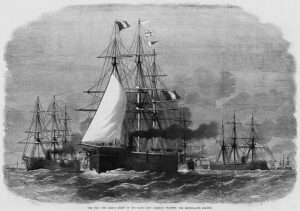 Surveillante (Guardian) was laid down at Arsenal de Lorient on 28 January 1861, launched on 18 August 1864 and completed on 21 October 1867 and assigned to the Ironclad Division, Northern Squadron in Cherbourg but in reserve on 28 April 1869. From 19 July 1870 she was mobilized under VADM Édouard Bouët-Willaumez’s squadron to blockade German ports in the Heligoland Bight. On 2 August he split his forces and Surveillante with one half proceeded into the Baltic under his command. On 22 August the Prussian corvette SMS Nymphe approached in the Bay of Puck off Danzig (modern Gdansk) firing two broadsides at the flagship at long range, chased off. Prussian coastal defenses prevented closer bombardment. They were ordered back to Cherbourg on 16 September. With the siege of Paris she was stripped of her trained gunners to defend the city. The blockade resumed until December. The ironclad lost her rudder in a storm on 12 October, towed back to Cherbourg by Guyenne. She was paid off on 1 April 1871, rearmed with new guns in 1873 and reactivated on 18 March 1876 for the Squadron of Evolutions, Channel Division. In 1877 she was transferred to the Mediterranean Squadron to protect French interests during the Russo-Turkish War of 1877–1878. She ran aground near Golfe-Juan on 1 February 1879, refloated. She was in reserve at Toulon on 14 February, reactivated on 1 March 1880 for trials, Mediterranean Squadron and took part in the French occupation of Tunisia in early 1881, landing 450 troops, horses and a mountain guns battery to Tabarka on 27 April.
Surveillante (Guardian) was laid down at Arsenal de Lorient on 28 January 1861, launched on 18 August 1864 and completed on 21 October 1867 and assigned to the Ironclad Division, Northern Squadron in Cherbourg but in reserve on 28 April 1869. From 19 July 1870 she was mobilized under VADM Édouard Bouët-Willaumez’s squadron to blockade German ports in the Heligoland Bight. On 2 August he split his forces and Surveillante with one half proceeded into the Baltic under his command. On 22 August the Prussian corvette SMS Nymphe approached in the Bay of Puck off Danzig (modern Gdansk) firing two broadsides at the flagship at long range, chased off. Prussian coastal defenses prevented closer bombardment. They were ordered back to Cherbourg on 16 September. With the siege of Paris she was stripped of her trained gunners to defend the city. The blockade resumed until December. The ironclad lost her rudder in a storm on 12 October, towed back to Cherbourg by Guyenne. She was paid off on 1 April 1871, rearmed with new guns in 1873 and reactivated on 18 March 1876 for the Squadron of Evolutions, Channel Division. In 1877 she was transferred to the Mediterranean Squadron to protect French interests during the Russo-Turkish War of 1877–1878. She ran aground near Golfe-Juan on 1 February 1879, refloated. She was in reserve at Toulon on 14 February, reactivated on 1 March 1880 for trials, Mediterranean Squadron and took part in the French occupation of Tunisia in early 1881, landing 450 troops, horses and a mountain guns battery to Tabarka on 27 April.
On 27 January 1882 she sailed for Brest and a refit until 8 May. She was placed in reserve on 3 July, in Cherbourg by December, reactivated on 15 April 1883 for the Trials Division until disbanded on 27 May. She then ferried French troops to Vietnam (Tonkin Campaign) and back to reserve on 16 June, decommissioned on 5 November 1884, condemned 13 May 1887 but guard ship at Cherbourg until stricken in 1890, coal storeship until BU 1898.
 Valeureuse
Valeureuse
Valeureuse was laid down at Arsenal de Brest on 23 May 1861, launched on 18 August 1864 and completed on 25 March 1867. “Valorous” had her definitive commission (armement définitif) on 25 March 1867, assigned to the Ironclad Division, Northern Squadron in Cherbourg. Then she was sent to the Squadron of Evolutions (Mediterranean Squadron) in November. She became flagship of Vice Admiral Edmond Jurien de La Gravière on 9 June 1868 but in reserve in April 1870. A premature detonation blew the breech of a 240 mm gun, killing 12.
When the war started on 19 July 1870, she was under Vice Admiral Léon Martin Fourichon which squadron departed for the Heligoland Bight Brest on 8 August, arrived off the island three days later. Neutral British denied permission to re-coal there so this was done at sea in bad weather with the storms from late August. They were forced to return in early September as the Prussians were besieging Paris. Many trained gunners were transferred to the city. She resumed the blockade with reduced crews until December. By January 1871 she searched for the German commerce raider SMS Augusta off the Gironde estuary and then blockaded Vigo in Spain, resupplying there. She was paid off on 1 April 1871 in Brest, in reserve for four years but recommissioned in December 1875 with 2nd Division, Northern Squadron in Cherbourg, decommissioned in July 1877 at Brest, stricken 26 February 1886, BU 1888.

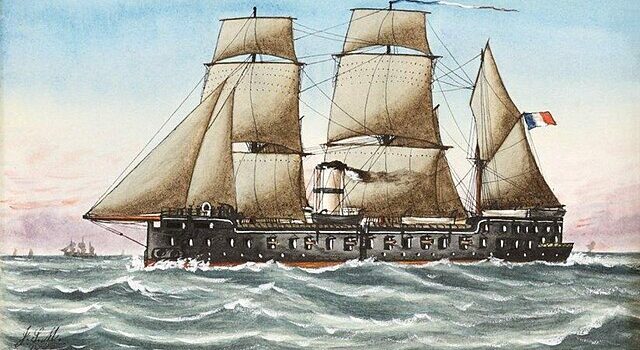

 Latest Facebook Entry -
Latest Facebook Entry -  X(Tweeter) Naval Encyclopedia's deck archive
X(Tweeter) Naval Encyclopedia's deck archive Instagram (@navalencyc)
Instagram (@navalencyc)





 French Navy
French Navy Royal Navy
Royal Navy Russian Navy
Russian Navy Armada Espanola
Armada Espanola Austrian Navy
Austrian Navy K.u.K. Kriegsmarine
K.u.K. Kriegsmarine Dansk Marine
Dansk Marine Nautiko Hellenon
Nautiko Hellenon Koninklije Marine 1870
Koninklije Marine 1870 Marinha do Brasil
Marinha do Brasil Osmanlı Donanması
Osmanlı Donanması Marina Do Peru
Marina Do Peru Marinha do Portugal
Marinha do Portugal Regia Marina 1870
Regia Marina 1870 Nihhon Kaigun 1870
Nihhon Kaigun 1870 Preußische Marine 1870
Preußische Marine 1870 Russkiy Flot 1870
Russkiy Flot 1870 Svenska marinen
Svenska marinen Søværnet
Søværnet Union Navy
Union Navy Confederate Navy
Confederate Navy Armada de Argentina
Armada de Argentina Imperial Chinese Navy
Imperial Chinese Navy Marinha do Portugal
Marinha do Portugal Mexico
Mexico Kaiserliche Marine
Kaiserliche Marine 1898 US Navy
1898 US Navy Sovietskiy Flot
Sovietskiy Flot Royal Canadian Navy
Royal Canadian Navy Royal Australian Navy
Royal Australian Navy RNZN Fleet
RNZN Fleet Chinese Navy 1937
Chinese Navy 1937 Kriegsmarine
Kriegsmarine Chilean Navy
Chilean Navy Danish Navy
Danish Navy Finnish Navy
Finnish Navy Hellenic Navy
Hellenic Navy Polish Navy
Polish Navy Romanian Navy
Romanian Navy Turkish Navy
Turkish Navy Royal Yugoslav Navy
Royal Yugoslav Navy Royal Thai Navy
Royal Thai Navy Minor Navies
Minor Navies Albania
Albania Austria
Austria Belgium
Belgium Columbia
Columbia Costa Rica
Costa Rica Cuba
Cuba Czechoslovakia
Czechoslovakia Dominican Republic
Dominican Republic Haiti
Haiti Hungary
Hungary Honduras
Honduras Estonia
Estonia Iceland
Iceland Eire
Eire Equador
Equador Iran
Iran Iraq
Iraq Latvia
Latvia Liberia
Liberia Lithuania
Lithuania Mandchukuo
Mandchukuo Morocco
Morocco Nicaragua
Nicaragua Persia
Persia San Salvador
San Salvador Sarawak
Sarawak Uruguay
Uruguay Venezuela
Venezuela Zanzibar
Zanzibar Warsaw Pact Navies
Warsaw Pact Navies Bulgaria
Bulgaria Hungary
Hungary

 Bundesmarine
Bundesmarine Dutch Navy
Dutch Navy Hellenic Navy
Hellenic Navy Marina Militare
Marina Militare Yugoslav Navy
Yugoslav Navy Chinese Navy
Chinese Navy Indian Navy
Indian Navy Indonesian Navy
Indonesian Navy JMSDF
JMSDF North Korean Navy
North Korean Navy Pakistani Navy
Pakistani Navy Philippines Navy
Philippines Navy ROKN
ROKN Rep. of Singapore Navy
Rep. of Singapore Navy Taiwanese Navy
Taiwanese Navy IDF Navy
IDF Navy Saudi Navy
Saudi Navy Royal New Zealand Navy
Royal New Zealand Navy Egyptian Navy
Egyptian Navy South African Navy
South African Navy






























 Ukrainian Navy
Ukrainian Navy dbodesign
dbodesign